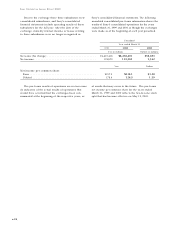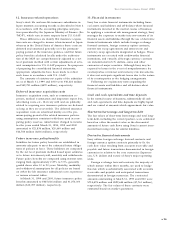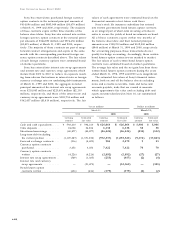Sony 2000 Annual Report Download - page 73
Download and view the complete annual report
Please find page 73 of the 2000 Sony annual report below. You can navigate through the pages in the report by either clicking on the pages listed below, or by using the keyword search tool below to find specific information within the annual report.
SONY CORPORATION ANNUAL REPORT 2000
71
distribution with respect to the amount appropriated by
resolution of the Board of Directors’ meeting.
Free distribution of common stock is recorded in
the financial statements only when it becomes effec-
tive, except for the calculation and presentation of per
share amounts.
Net income per share
Basic net income per share (“EPS”) is computed based
on the average number of shares of common stock
outstanding during each period and diluted EPS as-
sumes the dilution that could occur if securities or other
contracts to issue common stock were exercised or
converted into common stock or resulted in the issu-
ance of common stock. Basic and diluted EPS for the
current and prior years are adjusted to reflect stock split
that became effective subsequent to the date of the
financial statements but before the issuance of the
statements.
Common stock issue costs
Common stock issue costs are directly charged to
retained earnings, net of tax, in the accompanying con-
solidated financial statements as the Japanese Commer-
cial Code prohibits charging such stock issue costs to
capital accounts which is the prevailing practice in the
United States of America.
Recent pronouncements
Derivative instruments and hedging activities
In June 1998, the FASB issued Statement of Financial
Accounting Standards (“FAS”) No. 133, “Accounting
for Derivative Instruments and Hedging Activities”.
This standard requires all derivatives to be recognized
in the balance sheet as either assets or liabilities and
measured at fair value. To implement this standard,
all hedging relationships must be reassessed. In June
1999, the FASB issued FAS 137, “Accounting for
Derivative Instruments and Hedging Activities - Deferral
of the Effective Date of FASB Statement No. 133”.
The statement defers the effective date of FAS 133
for one year until fiscal year beginning after June 15,
2000. Sony will adopt this standard as of April 1,
2001. Sony is now in the process of assessing the
impact that this standard will have on Sony’s results
of operations and consolidated financial position.
Reclassifications
Certain reclassifications of the financial statements for
the years ended March 31, 1998 and 1999 have been
made to conform to the presentation for the year ended
March 31, 2000.
3. U.S. dollar amounts
U.S. dollar amounts presented in the financial state-
ments are included solely for the convenience of the
reader. These translations should not be construed as
representations that the yen amounts actually represent,
or have been or could be converted into U.S. dollars. As
the amounts shown in U.S. dollars are for convenience
only, the rate of ¥106 = U.S.$1, the approximate current
rate at March 31, 2000, has been used for the purpose
of presentation of the U.S. dollar amounts in the accom-
panying consolidated financial statements.
4. Integration of three listed subsidiaries
On January 5, 2000, Sony Corporation made three listed
subsidiaries, Sony Music Entertainment (Japan) Inc.
(“SMEJ”), Sony Chemicals Corporation (“SCC”) and Sony
Precision Technology Inc. (“SPT”), wholly owned sub-
sidiary companies through exchange offer procedures.
Prior to the exchange offer procedures, Sony Corporation
owned 71.0%, 69.6% and 69.2% of common stock of
SMEJ, SCC and SPT, respectively. SMEJ operates prima-
rily in the recording business; SCC is engaged in manu-
facturing and sale of recording media, electrical parts and
joint materials; and SPT is engaged in manufacturing and
sale of precise measuring and recording machines and
equipment. Sony Computer Entertainment Inc., which is
owned by Sony Corporation and SMEJ, also became a
wholly owned subsidiary company of Sony Corporation.
The share exchange ratios were one share of SMEJ,
SCC and SPT for 0.835 shares, 0.565 shares and 0.203
shares of Sony Corporation, respectively. As a result,
approximately 26,156 thousand, 5,606 thousand and
1,218 thousand shares of Sony Corporation’s common
stock were issued, respectively.
All of the exchanges were accounted for as pur-
chases. The fair value of the acquired minority interests
were determined based on the quoted market price of
¥10,550 ($100) per share of Sony Corporation for a few
days before and after March 9, 1999 when the terms of
the acquisition were agreed to and announced. The
costs of the acquired minority interest were ¥276,169
million ($2,605 million), ¥59,174 million ($558 million)
and ¥12,868 million ($121 million) for SMEJ, SCC and
SPT, respectively. The direct costs were included in the
cost of acquisition. The excess of the purchase price of
each subsidiary over the net assets acquired has been
allocated to identifiable assets such as land and intan-
gible assets (primarily the PlayStation trade name,
PlayStation format, music distribution agreements and
artist contracts), based upon the estimated fair value of
such assets, and relevant deferred tax liabilities. The
excess of the acquisition costs over the sum of the
amounts assigned to identifiable assets less liabilities
assumed is recognized as goodwill. Goodwill on this
transaction is being amortized on a straight-line basis
over a 20-year period.
























